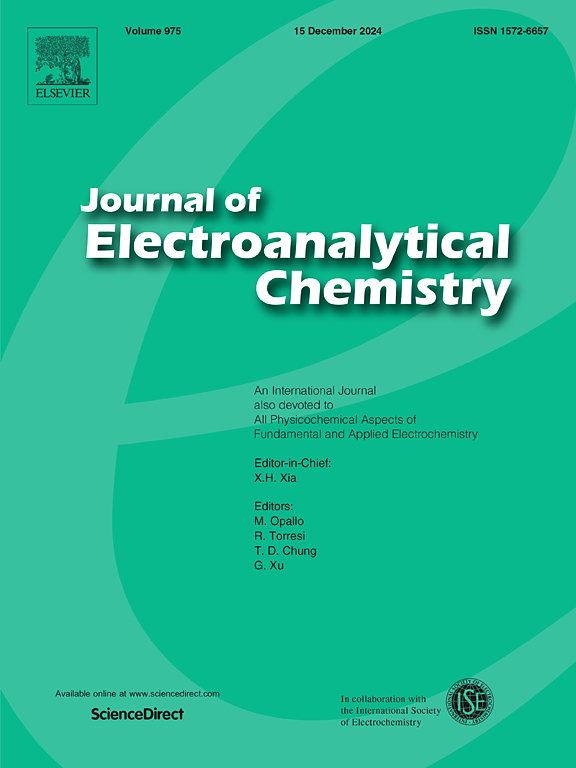Ultrasensitive detection of aquaporin-4 antibodies using ZIF-67@PDA@PtCu nanocomposite-based electrochemical immunosensor for neuromyelitis optica spectrum disorder diagnosis
IF 4.1
3区 化学
Q1 CHEMISTRY, ANALYTICAL
引用次数: 0
Abstract
Neuromyelitis optica spectrum disorder (NMOSD) is a central nervous system demyelinating disease that typically causes severe visual impairment and paralysis, and the aquaporin-4 antibodies (AQP4-IgG) serve as its specific diagnostic marker. In patients presenting with typical NMOSD symptoms, a positive AQP4-IgG result is sufficient to confirm the diagnosis. However, current clinical methods for detecting AQP4-IgG suffer from limited sensitivity, time-consuming procedures, and labor-intensive workflows, underscoring the urgent need for more efficient and reliable diagnostic approaches. To address these limitations, we report a novel electrochemical biosensor leveraging a hierarchical ZIF-67@PDA@PtCu nanozyme for ultrasensitive and rapid AQP4-IgG detection. ZIF-67@PDA@PtCu, a composite material consisting of a ZIF-67 core coated with polydopamine (PDA) and further decorated with PtCu nanoparticles, was utilized as a signal amplification component. The PtCu alloy nanoflowers demonstrated exceptional catalytic activity, which was further amplified by the sturdy ZIF-67 framework that enabled the integration of additional functional materials. In parallel, PDA enhanced the synergy between the unsaturated edge sites of the metal-organic framework and the outstanding catalytic properties of the PtCu alloy, thereby boosting the overall performance of the system. The integration of graphene oxide (GO) and gold nanoparticles (AuNPs) enhanced electrical conductivity. This configuration enabled efficient electrochemical (EC) signal generation, facilitating the detection of AQP4-IgG with high stability, a broad detection range of 0.1–80 U mL−1, and an impressively low detection limit of 0.05 U mL−1. Our findings offer a novel approach for the early diagnosis of NMOSD and provide valuable insights into the detection of other antibody-dependent neuroimmune disorders.
ZIF-67@PDA@PtCu纳米复合材料电化学免疫传感器超灵敏检测水通道蛋白-4抗体在视神经脊髓炎光谱障碍诊断中的应用
视神经脊髓炎谱系障碍(NMOSD)是一种中枢神经系统脱髓鞘疾病,通常导致严重的视力损害和瘫痪,水通道蛋白-4抗体(AQP4-IgG)是其特异性诊断标志物。在出现典型NMOSD症状的患者中,AQP4-IgG阳性结果足以确认诊断。然而,目前用于检测AQP4-IgG的临床方法存在灵敏度有限、程序耗时和劳动密集型的工作流程等问题,因此迫切需要更高效、更可靠的诊断方法。为了解决这些限制,我们报告了一种新型电化学生物传感器,利用分层ZIF-67@PDA@PtCu纳米酶进行超灵敏和快速的AQP4-IgG检测。ZIF-67@PDA@PtCu是一种复合材料,由包被聚多巴胺(PDA)的ZIF-67核心和PtCu纳米粒子修饰组成,用作信号放大元件。PtCu合金纳米花表现出优异的催化活性,坚固的ZIF-67框架进一步增强了这种活性,使其能够整合其他功能材料。同时,PDA增强了金属-有机骨架的不饱和边缘位点与PtCu合金优异的催化性能之间的协同作用,从而提高了体系的整体性能。氧化石墨烯(GO)和金纳米颗粒(AuNPs)的集成增强了导电性。该结构实现了高效的电化学(EC)信号生成,有利于AQP4-IgG的检测,具有高稳定性,0.1 ~ 80 U mL−1的宽检测范围和0.05 U mL−1的极低检出限。我们的研究结果为NMOSD的早期诊断提供了一种新的方法,并为其他抗体依赖性神经免疫疾病的检测提供了有价值的见解。
本文章由计算机程序翻译,如有差异,请以英文原文为准。
求助全文
约1分钟内获得全文
求助全文
来源期刊
CiteScore
7.80
自引率
6.70%
发文量
912
审稿时长
2.4 months
期刊介绍:
The Journal of Electroanalytical Chemistry is the foremost international journal devoted to the interdisciplinary subject of electrochemistry in all its aspects, theoretical as well as applied.
Electrochemistry is a wide ranging area that is in a state of continuous evolution. Rather than compiling a long list of topics covered by the Journal, the editors would like to draw particular attention to the key issues of novelty, topicality and quality. Papers should present new and interesting electrochemical science in a way that is accessible to the reader. The presentation and discussion should be at a level that is consistent with the international status of the Journal. Reports describing the application of well-established techniques to problems that are essentially technical will not be accepted. Similarly, papers that report observations but fail to provide adequate interpretation will be rejected by the Editors. Papers dealing with technical electrochemistry should be submitted to other specialist journals unless the authors can show that their work provides substantially new insights into electrochemical processes.

 求助内容:
求助内容: 应助结果提醒方式:
应助结果提醒方式:


